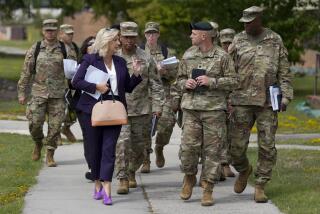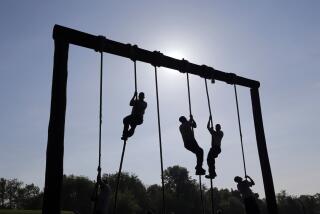Some Navy Recruits Go Back to School to Learn to Read : Illiteracy: The Navy faces a growing problem of recruits who read so poorly they must be sent back to the classroom.
Sixteen years ago, a machinist mate aboard a San Diego-based aircraft carrier was assigned to repair a generator. When the repair was completed, the generator was started and it immediately burned up.
An investigation showed that the machinist mate had carefully followed the photographs in the repair manual. But one step lacked pictures and the man inadvertently put the piston sleeves in upside down because he could not read the text.
The incident served as a poignant warning to Navy officials about the hazards posed by illiteracy, a problem the Navy has attempted to tackle for years.
Today, about one-fourth of new recruits perform academically at less than the ninth-grade level, and Navy officials expect the numbers to climb--a fact that thrusts the Navy into the role of schoolmarm.
With a shrinking pool of recruits to choose from and increasingly technical equipment that demands adequate reading skills to maintain, the Navy is feeling the illiteracy problem more acutely than ever.
Even a high school degree doesn’t guarantee a literate enlistee, recruiters find.
“A number of years ago, if somebody said he had a high school diploma, you assumed he could multiply, add, subtract and read. Those assumptions are not good anymore,” said Capt. Robert P. McClendon Jr., commanding officer of Recruit Training Command at San Diego’s Naval Training Center, which annually graduates about 28,000 enlistees. “Today, you get a kid who may have a degree but what he knows is anybody’s guess.”
And after last year, when the toll of those killed during training and standard operations numbered more than 100 Navy personnel--the highest in the decade--officials have launched a safety campaign that emphasizes the basics, including reading.
“Look at the sophisticated weapon system--you put a reduction gear in upside down and you’re talking about millions of dollars in damage. You read safety instructions wrong and you’ll electrocute yourself and others,” said William Maloy, director of instructional development with Naval Education and Training Command in Washington. “We’ve got to be able to depend on people to read and not fake it.”
Air Force manuals traditionally have been written at the ninth-grade level, which is the average required minimum reading level for recruits. Most Navy repair and training manuals are written for people who can read at least at the tenth-grade level, the average education level of their enlistees. To help recruits whose reading abilities prevent them from understanding these manuals, Navy officials have set up programs to combat a problem that only seems to grow.
Michael Hogan, a 20-year-old resident of West Valley City, Utah, graduated from high school two years ago. During his four years in high school, Hogan said, he read one book. It was a book for his sophomore English class and Hogan said he could no longer remember the title.
“School nowadays is not school,” Hogan said. “It’s a social life.”
Last year, 1,200 recruits who read at sixth-grade level or lower were enrolled in a special program at San Diego’s Naval Training Center; this year, officials expect 2,000 or about 11% of incoming recruits. And they expect to see these numbers continue to increase as more and more recruits arrive who cannot read.
San Diego is one of three locations in the country to offer the Fundamental Applied Skills Training program that improves recruits’ reading skills. In this program, about 95% of the student-recruits are high school graduates who read at sixth-grade level or lower, said Senior Chief Petty Officer Oliver Brown, the division officer in charge of the FAST program.
When Joseph “Jo Jo” Quintana first arrived at the program, he was able to read about 130 words a minute--about two words a second. Today, he has boosted that to 300 words a minute.
Quintana, a high school graduate, slid by in the civilian world without being able to read until he joined the Navy and showed up for boot camp. Before he was allowed to go through eight weeks of basic training, he was sent to a three-week reading program.
For him, not being able to read posed problems when he had worked as a TV cable installer. One day, Quintana couldn’t make any sense of the instruction sheet for installing cables that his boss had handed him. He was too embarrassed to admit it and got another worker to tell him what it said.
“I have had a problem reading ever since I was small. I used to daydream in school and I got by,” said Quintana, a Chicago native. “But now, I see what I was missing.”
For enlistees, the reading program is usually a rude shock. When they sign up for boot camp, they believe they are about to enter the eight-week program designed to build muscles and stamina. They don’t realize that if they can’t read, they will first be sent to an intensive remedial education program that can take from one to five weeks.
“Recruiters are so afraid that they not going to get the numbers of people they need that they don’t want to say anything,” said Diana Davidson, an instructor from San Diego Community College who works at the FAST program. “When the recruits come in, a lot of them are upset.”
Antonio Atkins, a 21-year-old Sweetwater, Texas, native, signed up for boot camp and learned that he was able to read at the seventh-grade level. Since English was his favorite subject in high school, this came as a surprise.
“I thought I was reading a lot higher than that. It had me down at first,” Atkins said. “Usually, I can read everything I get.”
Nationwide, there are an estimated 23 million adults in the United States who are illiterate. Studies show that 15% of the U.S. work force is functionally illiterate. And business, as well as the military, is trying to battle the problem. In 1988, private corporations spent $25 billion on employee reading and writing programs.
And for the military, the problem is heightened because many youths enlist rather than attend school. McClendon and others consider the FAST program a success in its efforts to help recruits catch up. The average recruit enrolled in the program advances two grade levels, Brown said. Each new enlistee, usually about 20 years old, costs the Navy $75 a day for the program. For about one-fourth of the pupils, English is not their native language.
Along with the ABCs, they learn acronyms such as SOPA (Senior Officer Present Afloat), POOW (Petty Officer of the Watch), and PMS (Planned Maintenance System). And their vocabulary lessons range from “maneuver” to “monkey fist,” (a knot), from “chow” to “dog,” (a latch).
McClendon is quick to point out that although some recruits may lack standard educational skills, they are not less smart.
“Being different doesn’t mean a lesser product but a different one,” he said. “We, the country, went through why-can’t-Johnny-read several years ago and lot of those Johnnys are here now.”
More to Read
Sign up for Essential California
The most important California stories and recommendations in your inbox every morning.
You may occasionally receive promotional content from the Los Angeles Times.










